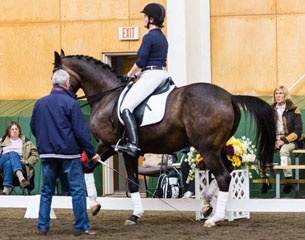
Retired German 4* I-judge and former Grand Prix competitor Angelika Frömming flew to Boston to give a seminar with renowned German trainer Johann Hinnemann at Pineland Farms in New Gloucester, Maine. For Eurodressage she wrote down her impressions of these days on the other side of the Atlantic.
The Training Scale in Theory and Practise at Pineland Farms
A seminar together with Johann Hinnemann in the USA? An interesting and exciting challenge for me, so I was delighted in advance. After we landed in Boston we were picked up at the airport by Jennifer and Elisabeth from Pineland Farms to continue the journey northwards. Two and a half hours in the car, interrupted for a short diner underway, and we finally arrived at Pineland Farms Equestrian Centre. It had been a long day indeed, but the curiousity which horses and riders we would meet there caused adrenaline, which kept tiredness at bay.
The seminar took place over two days and included lectures and practical riding demonstrations in turns. Apart from Johnann Hinnemann and me there were Richard Freemann, owner of Oak Hill Ranch and Dr. Maria Grant, a veterinarian, who were invited as lecturers. Freemann reported on his experiences as a breeder and his long-term cooperation with one of the USA's leading Grand Prix-riders, Heather Blitz. Dr. Grant spoke about an update on equine stem cell therapy research.
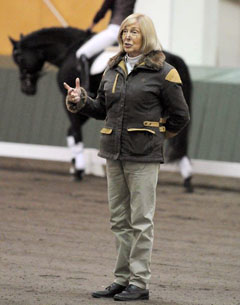 On the first day I was allowed to hold a power point presentation on the topic “Basic Paces and Dressage Movements from the Judge's Point of View – Necessary Requirements for High Marks in Test Movements.” My idea had been to show the 150 attendants of the seminar — riders, trainers, judges, breeders and equestrian enthusiasts — which requirements have to be fulfilled, formally and from a quality point of view, to achieve high marks in competitions. I did that based on the FEI rule book, the dressage handbook, photos and above all short film sequences. For that purpose I had chosen sequences of all thinkable movements, taken from pony and junior classes and from PSG- and GP classes, which at least allowed to be marked with a 7. During each video analysis an interesting exchange of opinions evolved which continued over the next two days. It was very important for me that during discussions the arguments were based on the training scale, resulting in harmonious and complemental discussions.
On the first day I was allowed to hold a power point presentation on the topic “Basic Paces and Dressage Movements from the Judge's Point of View – Necessary Requirements for High Marks in Test Movements.” My idea had been to show the 150 attendants of the seminar — riders, trainers, judges, breeders and equestrian enthusiasts — which requirements have to be fulfilled, formally and from a quality point of view, to achieve high marks in competitions. I did that based on the FEI rule book, the dressage handbook, photos and above all short film sequences. For that purpose I had chosen sequences of all thinkable movements, taken from pony and junior classes and from PSG- and GP classes, which at least allowed to be marked with a 7. During each video analysis an interesting exchange of opinions evolved which continued over the next two days. It was very important for me that during discussions the arguments were based on the training scale, resulting in harmonious and complemental discussions.
The second day kicked off with a common demonstration of the training scale. After a short historical overview of the development of equitation and the training scale itself, it became obvious that Johann Hinnemann's and my opinions are based on this identical basis. Moreover it became obvious that the training scale isn't only a guiding line for dressage, but for all disciplines, also for pleasure riding. For the practical part which was taken over by Johann Hinnemann there was a high quality team of riders on horses, ranging from a 4-year-old to at least three Grand Prix-horses, selected by former Olympian Michael Poulin. All participants rode on both days which again proved to be more than useful. Working with these riders wasn't only huge fun, but it also showed visible progress.
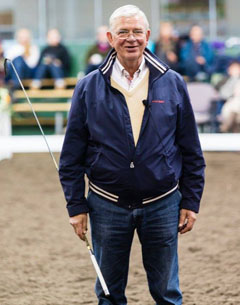 With first pair, Marie DiBicarri on the only 4-year-old Bazinga, a Hanoverian gelding by Belissimo M x Weltmeyer, Johann already made clear which are the three basics while training horses: Control of the hindquarters, the back and the contact through a safe hand-mouth-connection. Every single movement in our riding system makes sense and has a goal. But they can only be useful if executed correctly. This is also valid for riding on circles which is important for young and advanced horses alike and which took considerable time when working with this youngster at the seminar. To improve the young horse's relaxation Johann recommended repeated trot-canter-transitions. Leg-yielding can be used not only to prepare lateral work, but also to make the young horse accept the riders' aids and to improve the clear rhythm in walk.
With first pair, Marie DiBicarri on the only 4-year-old Bazinga, a Hanoverian gelding by Belissimo M x Weltmeyer, Johann already made clear which are the three basics while training horses: Control of the hindquarters, the back and the contact through a safe hand-mouth-connection. Every single movement in our riding system makes sense and has a goal. But they can only be useful if executed correctly. This is also valid for riding on circles which is important for young and advanced horses alike and which took considerable time when working with this youngster at the seminar. To improve the young horse's relaxation Johann recommended repeated trot-canter-transitions. Leg-yielding can be used not only to prepare lateral work, but also to make the young horse accept the riders' aids and to improve the clear rhythm in walk.
With David Collins and the 5-year-old Hanoverian Bojing the ever important movement of „chewing the reins out of the hand“ (stretching forwards-downwards by progressively giving the reins) was demonstrated and its relevance explained. Hinnemann stressed that this movement serves to check the throughness of a horse, but also to animate the horse to stretch the neck downwards from the withers on. As easy as this movement may sound, it requires a lot and subsequently it is often executed wrongly. Riders tend to neglect the even and impulsive action of the hindquarters and as a consequence horses fall apart and loose balance. To activate the hindquarters and improve the beginning collection Bojing was asked to do shoulder-fore and shoulder-in so that he activated the inner hind-leg more towards the centre of gravity. Also transitions between walk and shoulder-fore into the canter shoulder-fore proved to be helpful in that regards. A special highlight with this pair was the first flying change on the second day of the seminar. To achieve a good flying change it is necessary to have sufficient collection and a pronounced phase of suspension. Johann explained these neccessities through the fact that the horse changes the leg in this very phase and so is responsible for expressive changes. With Boijinga first the throughness was increased by executing simple canter changes at the same spot by slight lateral deviation from the straight line, simple change and continuing straight. It worked and after a short break also on the other lead. David Collins and his young Hanoverian received a lot of applause which provoked happy faces.
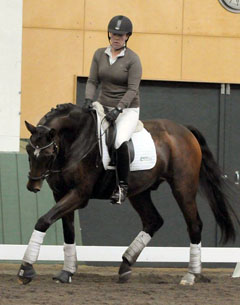 Gwyneth McPherson rode two horses in the seminar, the 6-year old KWPN bred Eskandar and the experienced 12-year-old Well Done. She first presented Eskandar which she had already warmed up in the warm autumn-sunshine outside. Pineland Farms, located in Maine, presented itself in the most wonderful sunshine and the trees had their Indian-summer leaves. Johann asked the rider to start quite early with half halts in the trot work so that the horse was forced to focus from the start on the rider's aids. During the canter work that followed the half halts became included in the work on the circle line. During these also a frequent change from shoulder-in and travers was asked which continued by diminishing the circle-line snail-house-like in travers and then enlarge it again in shoulder-in. All those exercises were used to make the horse more sensitive to the rider's aids, to improve the longitude and the activity in canter. The goal in the end was also a safely executed flying change. Here Johann warned the audience to practise the flying change in combination with a change of lead, for example by changing through a circle. He became even clearer in his reservations towards another method, the one teaching the horse to change by riding over a pole on the ground. With this way horses only learnt to execute the flying change in two phases.
Gwyneth McPherson rode two horses in the seminar, the 6-year old KWPN bred Eskandar and the experienced 12-year-old Well Done. She first presented Eskandar which she had already warmed up in the warm autumn-sunshine outside. Pineland Farms, located in Maine, presented itself in the most wonderful sunshine and the trees had their Indian-summer leaves. Johann asked the rider to start quite early with half halts in the trot work so that the horse was forced to focus from the start on the rider's aids. During the canter work that followed the half halts became included in the work on the circle line. During these also a frequent change from shoulder-in and travers was asked which continued by diminishing the circle-line snail-house-like in travers and then enlarge it again in shoulder-in. All those exercises were used to make the horse more sensitive to the rider's aids, to improve the longitude and the activity in canter. The goal in the end was also a safely executed flying change. Here Johann warned the audience to practise the flying change in combination with a change of lead, for example by changing through a circle. He became even clearer in his reservations towards another method, the one teaching the horse to change by riding over a pole on the ground. With this way horses only learnt to execute the flying change in two phases.
With the KWPN-gelding Well Done, Gwyneth's second horse, Johann showed the correct execution of the walk pirouette. Apart from the clear lateral bend it is important in this movement that it is induced correctly, executed in a clear four-beat and finished correctly which means controlled. Here the only difference between the international and the German understanding of execution of a movement becomes obvious: According to German rules the hind legs are allowed to cross during the last step whereas this is not wanted internationally. This means that the walk pirouettes can be finished a bit earlier in a forwards motion. To improve the already existent bend in the trot a combination of lateral movements such as shoulder-in and half-passes, including riding voltes, were ridden and they visibly increased the horse's suppleness. On the second day it was obvious that Well Done owns remarkably sensitive hindquarters which enable him to show a very expressive impulsive passage, truly coming from behind. To improve the quality of the cadence in the piaffe, which was shown already in a clear two beat, rider and trainer tried to take the cadence out of the passage into the piaffe while riding increasingly shorter sequences especially in the piaffe.
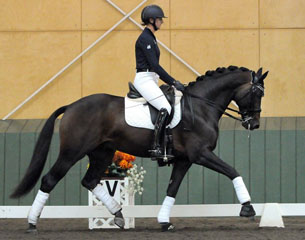 2012 Olympic reserve rider Heather Blitz presented an outstanding talent with the 6-year-old Danish bred Quarterback x Rohdiamant son Praestemarkens Quatero. This raw-diamond in the proverbial sense of the word has an amazing natural ability: the dressage movements seem to just come to him. For example he was technically already pretty safe in the serial flying changes and offered passage simply by himself, so that it is better not even to think of this movement at the moment. So it was the aim of both days to make the movements in trot not higher, bit longer so that Quatero could move even more relaxed. Johann recommended again and again to vary with the neck-position of which the stretching forwards-downwards was of special importance. Something which could be observed throughout the seminar as he would ask every single rider to finish a lesson like that. With the help of goal-orientated work on the circle-line in canter the flying changes became even more expressive and had an even more uphill tendency. At the end of both seminar days the horse showed, thanks to the sensitive impact of the rider, an expressive, swinging and big trot without any tense steps.
2012 Olympic reserve rider Heather Blitz presented an outstanding talent with the 6-year-old Danish bred Quarterback x Rohdiamant son Praestemarkens Quatero. This raw-diamond in the proverbial sense of the word has an amazing natural ability: the dressage movements seem to just come to him. For example he was technically already pretty safe in the serial flying changes and offered passage simply by himself, so that it is better not even to think of this movement at the moment. So it was the aim of both days to make the movements in trot not higher, bit longer so that Quatero could move even more relaxed. Johann recommended again and again to vary with the neck-position of which the stretching forwards-downwards was of special importance. Something which could be observed throughout the seminar as he would ask every single rider to finish a lesson like that. With the help of goal-orientated work on the circle-line in canter the flying changes became even more expressive and had an even more uphill tendency. At the end of both seminar days the horse showed, thanks to the sensitive impact of the rider, an expressive, swinging and big trot without any tense steps.
Heather's second horse, another Danish bred, was a 7-year-old stallion by Hotline x Cavan. With Ripline Johann demonstrated mainly the preparation work for canter pirouettes. For Hinnemann the sequence of canter-pirouette—flying change—canter pirouette is the touchtone of collection and control. For the difficult canter pirouette the canter needs to be very collected, sitting and also small. The problem begins with many horses already when they depart into canter from the walk, the trot or the passage. The very first canter stride already needs to be sitting and straight, no matter from which gait or movement. The horses need to feel home on the centre-line which means they are neither allowed to become hectic nor loose impulsion. So the even straightening in canter on the centre line, the quarter-lines and the diagonals was repeatedly exercised. The next precondition for sitting canter pirouettes is the ability of the horse to sit and to maintain the bend in the shoulder fore. Consequently Johann asked not only Heather but several riders in the seminar to ride significant tempi differences on the centre line and shoulder-fore in canter. They occasionally practised riding a working canter and then a medium tempo while occasionally stretching forwards-downwards to prevent tension from occurring.
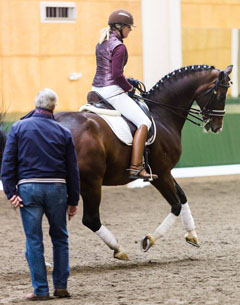 Danielle Gavriluk and her Hanoverian High Life (by Hohenstein) were very confirmed in the movements, but the collected work in trot was at the beginning less expressive compared to the canter. Johann successfully improved this with his tips. Whereas one rather has to take care of the length of trot steps in the daily work, it was important here to improve the height of the steps. At the beginning the rider was asked to make the horse more lively and stepping more under by animating it more energetically with both calves simultaneously. Moreover Johann recommended the rider to change slightly the head-neck-position by allowing the horse to carry the neck from the withers on a bit deeper so that his back is able to come up more and be strengthened in that way. After that he asked the rider of the already expressively passaging horse to come back gradually into trot by still thinking passage without doing it. These transitions were repeated as soon as the horse tended not to step up significantly enough. High Life understood the efforts of his rider and after some time, in particular on the second day, the horse showed activity and stepping under in the trot work without any passagey steps in his way to trot. It was a really impressive success of rider, trainer and horse which the onlookers could witness.
Danielle Gavriluk and her Hanoverian High Life (by Hohenstein) were very confirmed in the movements, but the collected work in trot was at the beginning less expressive compared to the canter. Johann successfully improved this with his tips. Whereas one rather has to take care of the length of trot steps in the daily work, it was important here to improve the height of the steps. At the beginning the rider was asked to make the horse more lively and stepping more under by animating it more energetically with both calves simultaneously. Moreover Johann recommended the rider to change slightly the head-neck-position by allowing the horse to carry the neck from the withers on a bit deeper so that his back is able to come up more and be strengthened in that way. After that he asked the rider of the already expressively passaging horse to come back gradually into trot by still thinking passage without doing it. These transitions were repeated as soon as the horse tended not to step up significantly enough. High Life understood the efforts of his rider and after some time, in particular on the second day, the horse showed activity and stepping under in the trot work without any passagey steps in his way to trot. It was a really impressive success of rider, trainer and horse which the onlookers could witness.
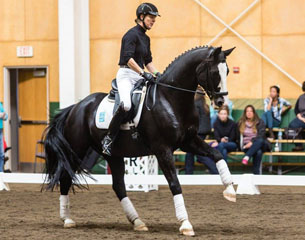 Jutta Lee and her Württemberger Glorious Feeling showed confirmed expressive half-passes, an active passage and technically safe tempi changes. With this horse Johann demonstrated the change of bend and direction in the zig-zag-canter-half-passes. It became clear that training and competition are two pairs of shoes in that case, requiring two different ways of execution. In the daily work for improving the suppleness, the quality of the canter and the flying change an early change of bend in the neck is done. But this means that occasionally the last two canter strides are executed as „counter half-pass“ which of course is a mistake in competitions. There the flying change has to be done straight and the bend of the neck just before has to be almost “invisible”. Work on piaffe with this pair meant to improve the rhythm. To achieve this Johann encouraged the rider to shorten the passage until it was almost on the spot and to often repeat these transitions from a more forward going passage to a very collected one. This so—called concertina-effect promises in this case a long-term success. An alternative to increase the rhythm in piaffe can be seen in the possibility to piaffe out of the (diagonal) rein-back.
Jutta Lee and her Württemberger Glorious Feeling showed confirmed expressive half-passes, an active passage and technically safe tempi changes. With this horse Johann demonstrated the change of bend and direction in the zig-zag-canter-half-passes. It became clear that training and competition are two pairs of shoes in that case, requiring two different ways of execution. In the daily work for improving the suppleness, the quality of the canter and the flying change an early change of bend in the neck is done. But this means that occasionally the last two canter strides are executed as „counter half-pass“ which of course is a mistake in competitions. There the flying change has to be done straight and the bend of the neck just before has to be almost “invisible”. Work on piaffe with this pair meant to improve the rhythm. To achieve this Johann encouraged the rider to shorten the passage until it was almost on the spot and to often repeat these transitions from a more forward going passage to a very collected one. This so—called concertina-effect promises in this case a long-term success. An alternative to increase the rhythm in piaffe can be seen in the possibility to piaffe out of the (diagonal) rein-back.
Sharon McCusker and her KWPN bred Wrigley were a confirmed, expressive Grand Prix pair. Johann improved with both the work in canter on the centre-line which is required in the Grand Prix-programmes: canter-pirouettes-flying changes-canter-pirouettes. He gave the tip to induce the canter-pirouette slightly off the centre-line so that the first stride of the pirouette touches the centre-line and the circular arc the hindquarters describe looks smaller than when a rider begins exactly on the centre-line and then deviates from it in the first canter-stride. Also for the execution of the mainly confirmed piaffe and passage Johann had a decisive suggestion for improvement: At the end of piaffe not slowing down in tempo, but ideally increase, at least maintain it. Then the transition into passage is easier for the horse. Remarkable to note: Let the horse do the work!
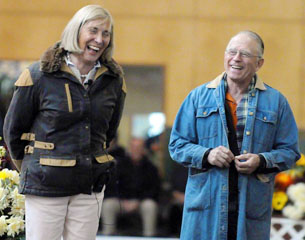 After two exciting seminar days at Pineland Farms there is much gratitude and contentment. The conditions for seminars there are excellent for horses, riders, spectators and course instructors alike. Michael Poulin encouraged a high class group of riders to attend and almost all of them are his students for which I am grateful. Jennifer Dillon turned out to be a true organisation pro because it wasn't easy at all to reconcile everything beforehand. The riders and horses deserve an extra big thank you for their enthusiasm. The same goes for the 150 auditors who almost all stayed from dusk till down. And last but not least a special thank-you to Johann Hinnemann as it was a wonderful experience to hold a seminar with him.
After two exciting seminar days at Pineland Farms there is much gratitude and contentment. The conditions for seminars there are excellent for horses, riders, spectators and course instructors alike. Michael Poulin encouraged a high class group of riders to attend and almost all of them are his students for which I am grateful. Jennifer Dillon turned out to be a true organisation pro because it wasn't easy at all to reconcile everything beforehand. The riders and horses deserve an extra big thank you for their enthusiasm. The same goes for the 150 auditors who almost all stayed from dusk till down. And last but not least a special thank-you to Johann Hinnemann as it was a wonderful experience to hold a seminar with him.
By Angelika Frömming for Eurodressage.com, edited by S. Rottermann
Photos © Donna Allen
Related Links
Angelika Fromming: Open Scoring and Expert Commentary to Popularize Dressage
Angelika Fromming: Half a Century of Dressage
Fromming Stresses Objectivity at 2012 Portuguese Judging Clinic
Q & A Session on the State of Dressage with I-Judge Angelika Fromming